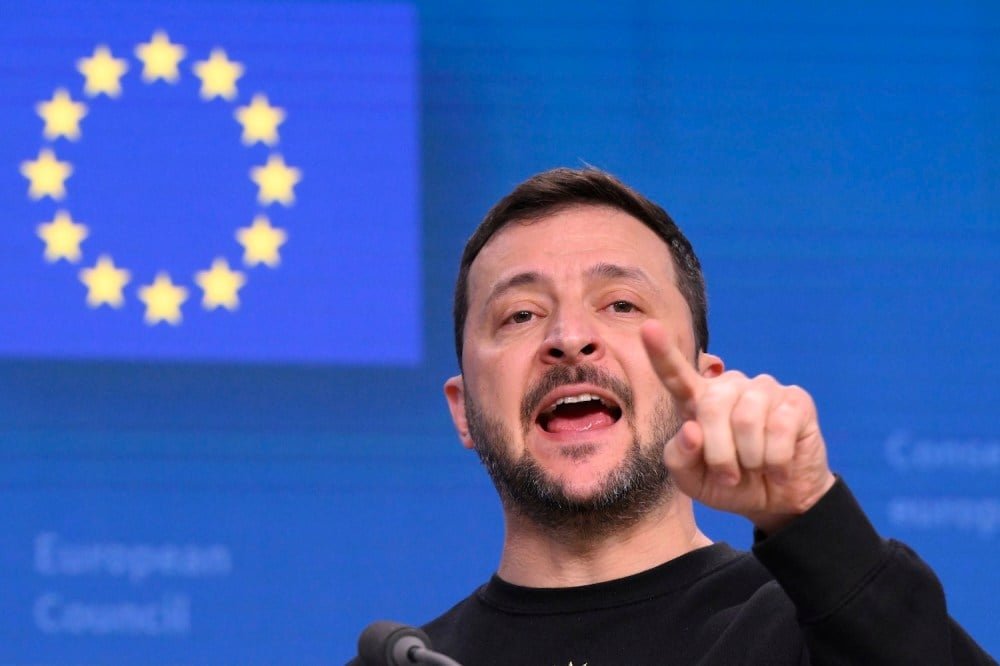Will Trump Pressure Ukraine to Cut a Deal?
If Washington pressures Kyiv and Zelensky refuses to accept a peace deal, he could turn to Europe for support instead.

By Emma Ashford, a columnist at Foreign Policy and a senior fellow with the Reimagining U.S. Grand Strategy program at the Stimson Center.

Ukrainian President Volodymyr Zelensky gives a press conference on the sidelines of a European Union summit in Brussels, on Oct. 17. Jon Thys / AFP
The clearest change that U.S. President-elect Donald Trump is likely to make on foreign policy is in Ukraine. Republican support for spending more on sending weapons to Kyiv has been declining, and Trump will probably follow through on his promise to seek a peace deal.
The problem is that peace will likely come at terms that do not favor Kyiv. Now, Ukraine’s military losses have begun to mount, and the practical barriers to continued support to Ukraine—declining Western stockpiles, Ukraine’s significant manpower and corruption problems—have increased. Trump has a popular mandate to seek a settlement, even though Europeans might object.
The clearest change that U.S. President-elect Donald Trump is likely to make on foreign policy is in Ukraine. Republican support for spending more on sending weapons to Kyiv has been declining, and Trump will probably follow through on his promise to seek a peace deal.
The problem is that peace will likely come at terms that do not favor Kyiv. Now, Ukraine’s military losses have begun to mount, and the practical barriers to continued support to Ukraine—declining Western stockpiles, Ukraine’s significant manpower and corruption problems—have increased. Trump has a popular mandate to seek a settlement, even though Europeans might object.
What, then, would a settlement in Ukraine look like? The territorial question will be settled by facts on the ground: Russia’s recent gains suggest that this will be worse for Ukraine than it would have been a year ago. The Kursk incursion could give the Ukrainians some leverage, but only if they can succeed in holding it.
Then there are the bigger strategic questions. Kyiv insists that any peace deal must include a security guarantee, ideally via NATO; Russia isn’t likely to tolerate this. Despite what Ukrainian leaders say publicly, a minimum acceptable deal for Kyiv might look more like Ukrainian sovereignty, the ability to arm itself with Western help, and economic integration into Europe.
Trump is well placed to put pressure on Kyiv, but he and his advisors should be under no illusions that they can force Kyiv to the negotiating table.
It’s possible that whatever deal is negotiated—particularly if it is negotiated over the heads of Ukrainians—would be politically unacceptable to the Zelensky government. Kyiv might opt to keep fighting and seek European support instead.
For the Trump administration, the choice would be whether to continue to support Ukraine or to step back and drop the problem on Washington’s European allies.
This post is part of FP’s live coverage with global updates and analysis throughout the U.S. election. Follow along here.
Emma Ashford is a columnist at Foreign Policy and a senior fellow with the Reimagining U.S. Grand Strategy program at the Stimson Center, an adjunct assistant professor at Georgetown University, and the author of Oil, the State, and War. X: @EmmaMAshford
Read More

What Trump’s Win Will Mean for NATO, Ukraine, Israel, and Iran
Foreign policy might have mattered in the election after all—but mainly in Michigan.

Ukraine Now Faces a Nuclear Decision
Under a new Trump administration, Ukraine’s government can’t avoid considering a nuclear weapon.

Even Trump Can’t Afford to Lose the Ukraine War
Victory for Putin would be a grave blow to U.S. power.
More from Foreign Policy

Russia Can’t Keep Spending Like This for Long
Moscow is depleting its rainy-day savings to plug its war-induced fiscal deficit while preserving social stability.

The Next AI Debate Is About Geopolitics
Data might be the “new oil,” but nations—not nature—will decide where to build data centers.

The Enduring Mystery of Trump’s Relationship With Russia
After years of government investigations, we still don’t know if the former president is actually in Putin’s pocket.

The Case for the Greater West
Washington should abandon liberal universalism and work with the empire it already has.
Trending
![]()
Sign up for World Brief
FP’s flagship evening newsletter guiding you through the most important world stories of the day, written by Alexandra Sharp. Delivered weekdays.
By submitting your email, you agree to the Privacy Policy and Terms of Use and to receive email correspondence from us. You may opt out at any time.
